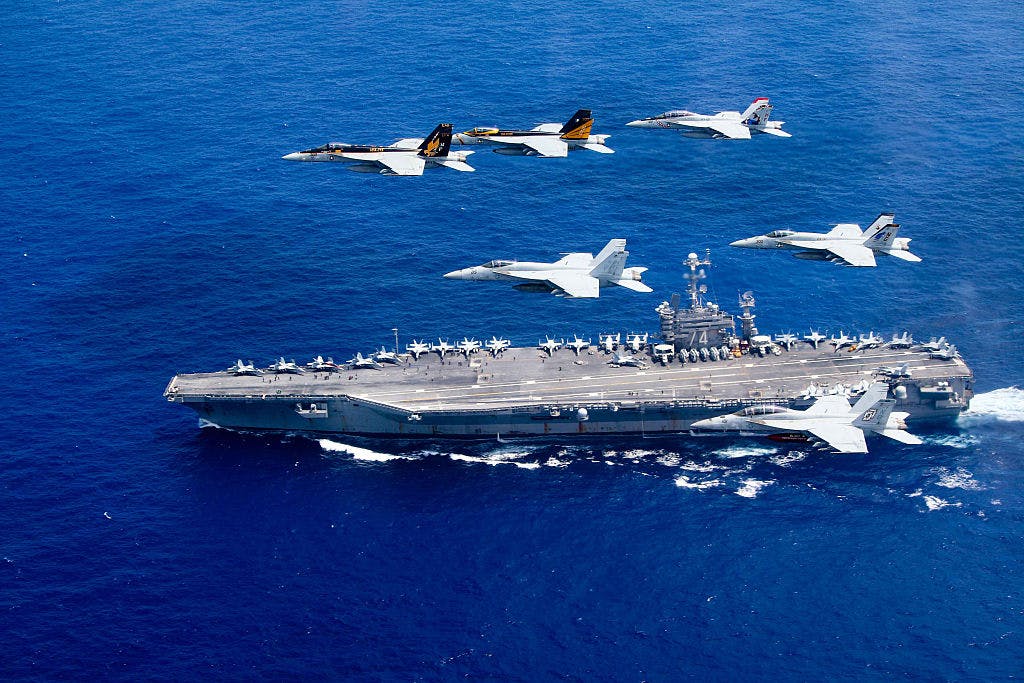American Navy Begins Building New Warships as the People’s Liberation Army Expands Its Ambitions on the Seas
The Chinese navy, the biggest in the world by number of hulls, is threatening to outshine America’s.

The US Navy is beginning construction on a new kind of warship — the USS Constellation (FFG-62) — as part of an effort to grow America’s shipbuilding industrial base that is increasingly rivaled by the Chinese navy.
The construction of this new class of frigates commenced on Friday at a new facility in Fincantieri Marinette Marine in Wisconsin through a Navy contract for ten ships announced in 2020 that could be worth more than $5.5 billion. The Navy is transitioning toward more heavily-armored frigates and away from littoral combat ships, after several major vessels that each cost $500 million in taxpayer dollars broke down at sea.
The People’s Liberation Army Navy, meanwhile, is catching up. The Pentagon’s 2023 report on Communist Chinese military power estimates that President Xi’s navy is about 370 warships and will grow to 395 ships by 2025 and 435 ships by 2030. That makes it the biggest navy in the world by number of hulls. The American fleet, on the other hand, is currently around 280 vessels and on track to reach 300 in the early 2030s.
The decimation of America’s prowess on the seas is drawing growing bipartisan concern at Capitol Hill. “Over the last 20 years, the United States has lost industrial shipbuilding capacity while China’s subsidized shipbuilding has only grown,” a group of Democratic senators asserted in a statement this week. They point to the fact that America led the world in commercial shipbuilding after World War II. Today, it produces fewer than 1 percent of the world’s commercial vessels.
The senators are calling on the Biden administration to probe “China’s unfair trade practices in commercial shipbuilding that undermine American workers and jeopardize our national security.” They warn that Beijing is building its military prowess through predatory practices like seizing sensitive information on the global flow of goods.
So-called realist foreign policy hawks are also sounding the alarm bells. Senator Vance has warned his colleagues on Capitol Hill that America lacks the military stockpiles to support three conflicts across Europe, the Middle East, and Asia. The equipment already sent to Ukraine, he says, has depleted America’s ability to defend Free China in the event of a Communist Chinese attack.
A retired American officer, Lieutenant Colonel Daniel Davis, tells the Sun how hard it is to replace these deficiencies: “It takes years to build new tanks — Abrams or Bradleys or any of these other kinds of high-end weapons systems — years.”
The Army, meanwhile, faces recruiting problems. The number of active-duty soldiers has dropped by about 30,000 from 2021 through 2024, a turn from a surge after 2001. Shortages have prompted Army leaders to reduce special operation forces — even the Air Force, Navy, Army, and Marine Corps have created new units dedicated to the issue — to prioritize the potentially more catastrophic possibility of a large-scale war with Communist China.
Some Republicans have even looked to shutter defense department agencies. The chairman of the House Armed Services Committee, Mike Rogers, proposed in June closing the Defense Department’s long-standing team of analysts, the Cost Assessment and Program Evaluation. Founded in 1961, that office is charged with overseeing the use of taxpayer dollars in the Pentagon and says that its mission is to help the Defense Department make “hard choices.”
The choices might only get harder amid an increasingly assertive Chinese military posture in the Taiwan Strait. As the editorial page editor of the Wall Street Journal, Paul Gigot, warned in a speech at the American Enterprise Institute last fall, “We are facing an array of adversaries that is more formidable than at any time since World War II, and we aren’t prepared for the moment.”

